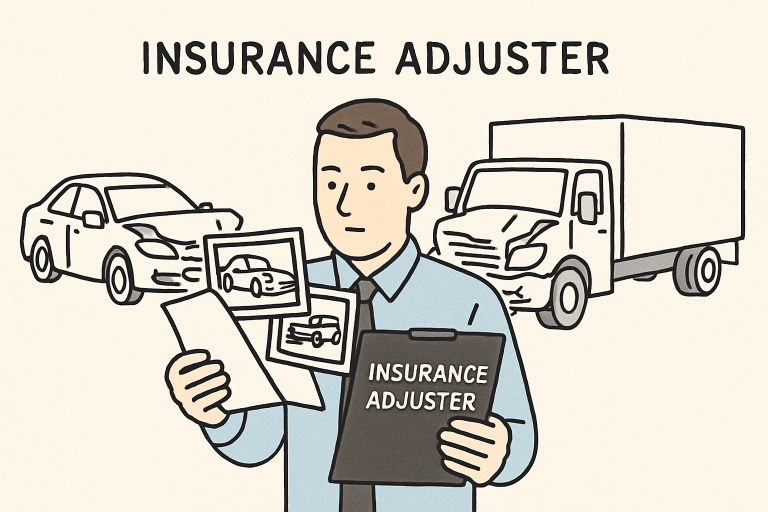Table of Contents
Introduction
When a truck accident unfolds on the road, unraveling who is responsible can become a complex and stressful experience. Many accident victims find themselves quickly approached by insurance representatives seeking details. Knowing how insurance adjusters approach these situations is crucial for any truck accident claim, as their findings directly impact your ability to recover compensation for injuries, damages, and losses. Insurance adjusters work to protect their company’s interests by relying on evidence, legal rules, and negotiation tactics. For truck accident cases, the process is especially complex due to regulations and higher risks. Victims must be cautious from the start, as early actions and responses can greatly affect the claim’s outcome. Since procedures differ by state and insurer, knowing your legal rights and the evidence-gathering process is key to building a strong case.

Evidence Collection
Insurance adjusters initiate their investigation by gathering all relevant evidence associated with the accident. This documentation forms the backbone of their analysis and ultimately informs their decisions regarding fault and compensation. The most common sources of evidence include:
- Police Reports: These official records provide details like the involved parties, time, location, observations, and sometimes a preliminary assessment of fault. Adjusters rely on these documents for foundational information and for clues about traffic violations or impaired driving.
- Photographs and Videos: Visuals from the accident scene – such as pictures of vehicle positions, skid marks, debris, weather, or traffic signals – are valuable for reconstructing the events leading up to the crash.
- Medical Records: Certified documentation of injuries helps establish the extent of physical harm and reinforces the legitimacy of the claim. It can also reveal the timeline and mechanics of injuries consistent with the crash scenario.
By collecting objective evidence from these various sources, adjusters can form a more accurate understanding of what happened and which party or parties might bear responsibility.
Analysis of Physical Damage
The pattern, location, and extent of physical damage to all vehicles involved are critical factors in determining both causation and liability. For instance, rear-end collisions where a truck strikes another vehicle from behind often point to the truck driver’s fault, but exceptions can occur depending on additional evidence. Adjusters examine:
- Impact zones and deformation on vehicles
- Paint transfer and residue patterns
- Mechanical failures or contributing vehicle defects
This analysis may also involve input from automotive repair experts or accident reconstruction specialists, particularly in severe or multi-vehicle incidents. The goal is a clear understanding of how and why the damage occurred, ultimately supporting or disputing liability claims.
Witness Statements and Police Reports
Eyewitnesses and official police documentation frequently play pivotal roles in accident investigations. Insurance adjusters gather and compare witness statements provided at the scene or in follow-up interviews. These accounts may corroborate, challenge, or add nuance to the parties’ own versions of events. However, according to Verywell Mind, eyewitness testimony is not always reliable and may be influenced by memory distortions or stress.
Police reports are carefully reviewed not only for factual details but for officer observations, scene diagrams, and any citations or arrests made. If the officer documented evidence of negligence or risky behavior, adjusters weigh that heavily in their assessment.
Use of Technology
Modern commercial trucks are equipped with sophisticated electronics that can provide critical, objective evidence for accident investigation. Key examples include:
- Electronic Logging Devices (ELDs): These devices track hours of service, breaks, driving patterns, and compliance with federal regulations, which can reveal whether driver fatigue was a factor. According to Business.com, electronic logging devices are widely used in the trucking industry to improve safety and ensure regulatory compliance.
- Event Data Recorders (EDRs): Often referred to as “black boxes,” EDRs record information such as vehicle speed, braking, acceleration, and steering input in the moments before a collision.
- Surveillance and Dash Camera Footage: These sources can offer impartial, real-time evidence about traffic conditions, weather, and the behavior of all involved drivers.
Technology-driven evidence is considered highly reliable, and adjusters increasingly rely on it to resolve conflicting accounts or ambiguous situations.
Common Tactics Used by Insurance Companies
Insurance companies have significant financial motivation to minimize settlement payments, and adjusters often use strategies to achieve that aim. Common tactics include:
- Quick Settlement Offers: Early offers may be far less than the full value of your claim, particularly if future medical treatment or lost earnings are not yet known.
- Shifting Blame: Insurers may attempt to assign partial or complete fault to the claimant, for example, by suggesting distraction or traffic violations, as this reduces their financial responsibility.
- Delaying the Claims Process: Prolonged investigations or requests for additional documentation can wear down claimants or increase financial pressure, leading to faster, lower settlements.
Staying aware of these tactics enables claimants to respond effectively and avoid pitfalls that can impact the outcome of their case.
Legal Considerations
Laws governing fault and compensation in truck accidents vary considerably by state. Some follow “comparative negligence” rules, adjusting compensation based on each party’s share of fault, while others adhere to stricter “at-fault” or “no-fault” models. Understanding these rules is essential for truck accident claimants.
Because insurance negotiations can be complex, seeking professional legal advice ensures that your interests are represented accurately and that you understand the full scope of recoverable damages. Working with attorneys or legal advocates experienced in truck accident cases also helps you navigate overlapping issues involving federal trucking regulations, multiple insurance carriers, and extensive documentation.
Conclusion
Determining fault in truck accident claims is a detailed process involving evidence collection, damage analysis, witness interviews, and advanced technological data. The methods used by insurance adjusters, combined with common negotiation tactics, mean that accident victims must approach the process with good information and sound support. By understanding these steps and knowing when to seek professional guidance, you maximize your chances of receiving fair compensation and protecting your future.

